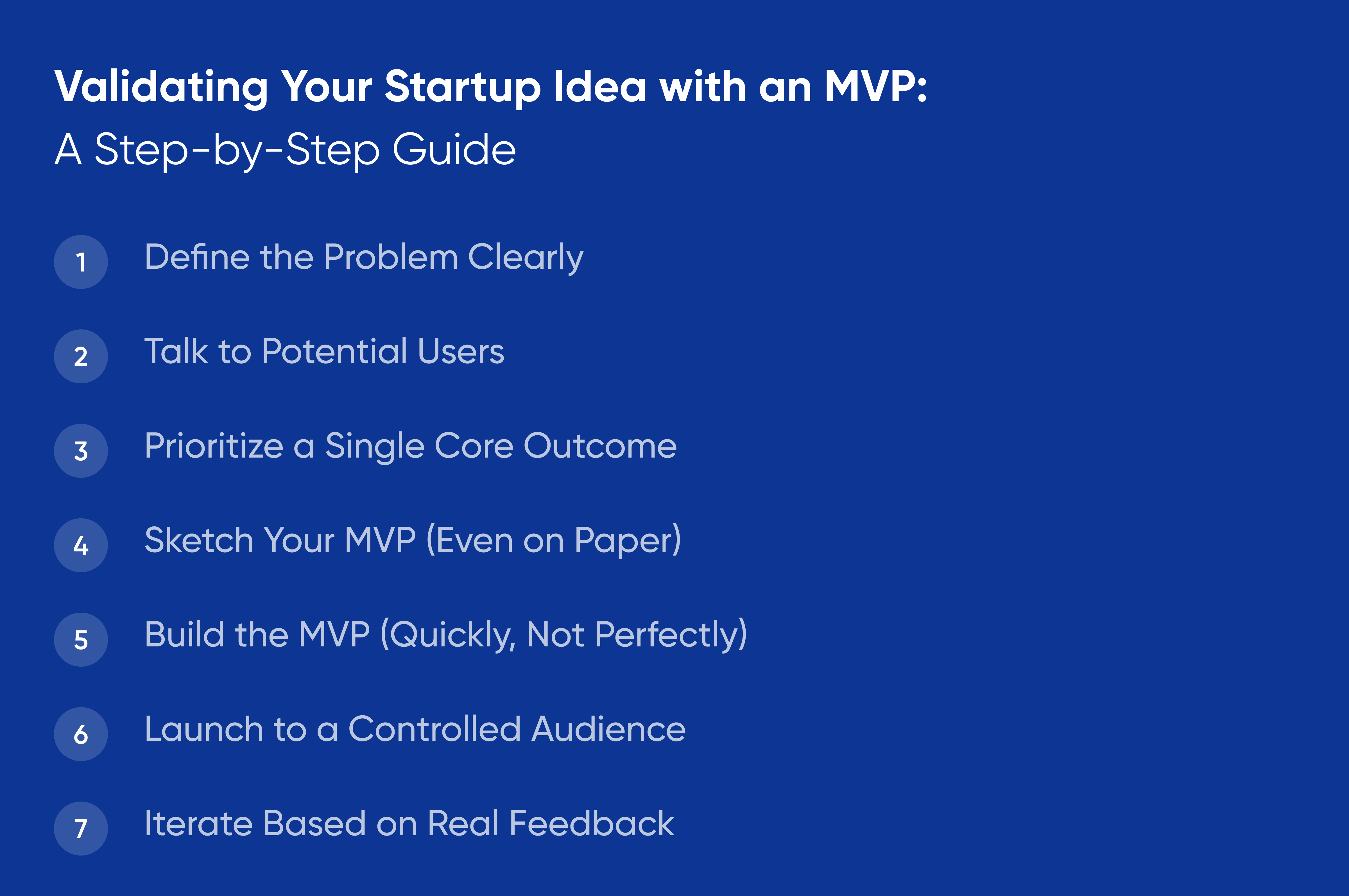Before you pour months into building your product, you need to answer a single question: Does anyone want this?
Too many startups launch with a beautiful app that no one uses. Why? Because they skipped the most important step — validation.
Validating your idea with an MVP (Minimum Viable Product) helps you confirm demand before you overinvest. It’s your shortcut to proving real market interest, securing feedback, and attracting early adopters or investors — without betting the whole farm.
Let’s break down the validation process into practical steps:

Step 1: Define the Problem Clearly
Before you build anything, you need to know exactly what user pain point you’re solving. And it has to be real — not just a minor inconvenience.
Ask:
- What specific problem does my user face?
- Who experiences this problem most urgently?
- What do they do today to solve it (if anything)?
Tip: If you can’t describe the problem in one sentence, you’re not ready to build.
Example: "Remote teams struggle to track async feedback on design files."
Step 2: Talk to Potential Users
This isn’t optional. Before designing or coding, speak with 10–30 people who match your ideal customer profile.
You’re not selling — you’re listening. Ask open-ended questions:
- How do you handle [problem] now?
- What tools do you use?
- What frustrates you most about that?
- Would you pay to solve it? Why or why not?
Red flag: If people say, “That’s interesting,” but don’t ask follow-up questions or offer to try it — they’re not that interested.
Green light: People say, “I need this. Can you let me know when it’s live?”
Step 3: Prioritize a Single Core Outcome
Your MVP shouldn’t solve every problem. It should prove one outcome.
Example: A project management startup might not need timelines, Kanban boards, and AI scheduling from day one. But if your MVP shows that users stick around after creating one project and inviting a teammate — that’s gold.
Ask: “What’s the smallest version of our product that can still deliver this outcome?”
Step 4: Sketch Your MVP (Even on Paper)
You don’t need a finished design to validate.
Start with:
- Wireframes (tools like Figma or Balsamiq)
- Flowcharts or even napkin sketches
- Clickable prototypes using tools like Marvel, Figma, or InVision
The goal? Show people what you’re planning and observe their reactions.
At Movadex, we often help founders test clickable mockups before development. You’d be amazed what insights you get from five user interactions.
Step 5: Build the MVP (Quickly, Not Perfectly)
Once you’ve gotten strong signals that people want your product, it’s time to build a testable version.
Use a fast, lean tech stack. Think:
- Firebase or Supabase for backend
- React Native or Flutter for mobile apps
- Next.js or Vue for web MVPs
Your MVP should:
- Be live in under 6–8 weeks
- Focus only on the 1–2 killer features
- Include basic analytics (so you can measure real use)
Reminder: Done is better than perfect. Launch > Polish.
Step 6: Launch to a Controlled Audience
Don’t just drop your MVP on Product Hunt and pray.
Start small:
- Reach out to your original interviewees
- Use founder communities (Indie Hackers, Reddit, Slack groups)
- Incentivize early users to give feedback
Track:
- Are users completing the main task?
- Are they coming back?
- What questions or support requests keep popping up?
Step 7: Iterate Based on Real Feedback
This is the magic moment. Use data and user interviews to find patterns:
- Are users asking for the same new feature?
- Do they get stuck at the same point?
- What’s their biggest praise/complaint?
At this point, many startups pivot — and that’s good! Validation isn’t about proving you’re right. It’s about learning what works.
Bonus: What If You Get a “No”?
If users don’t care — rejoice. You just saved yourself months of wasted development.
Now go back, refine your idea, and test again. The best startup founders treat MVPs like experiments — not products. Your goal isn’t to be right — it’s to discover what actually works.
Movadex Can Help
Our team at Movadex specializes in rapid MVP design and development. We help founders like you validate ideas before they commit fully — saving money, time, and heartache.
If you’ve got a promising startup concept and need a prototype, design, or development partner to test it fast, let’s talk.




